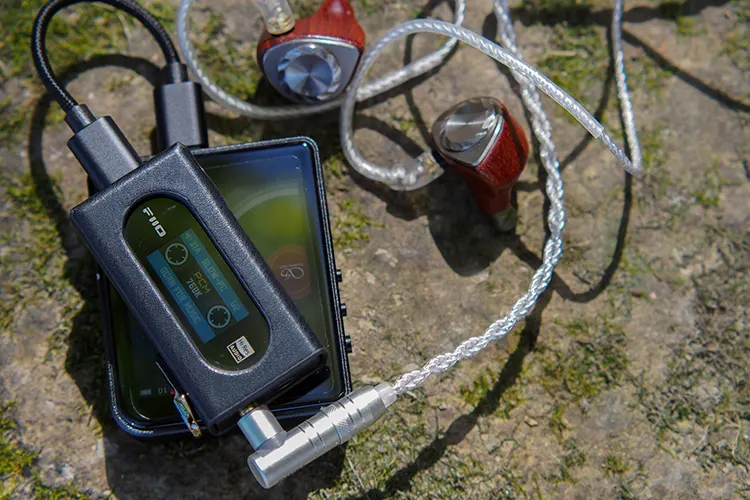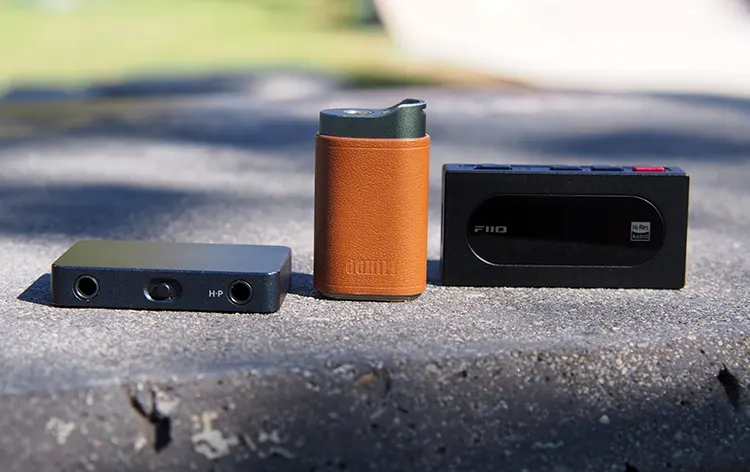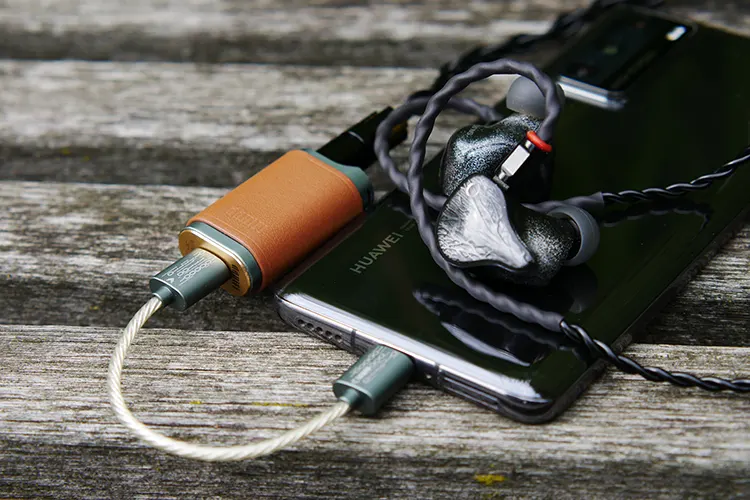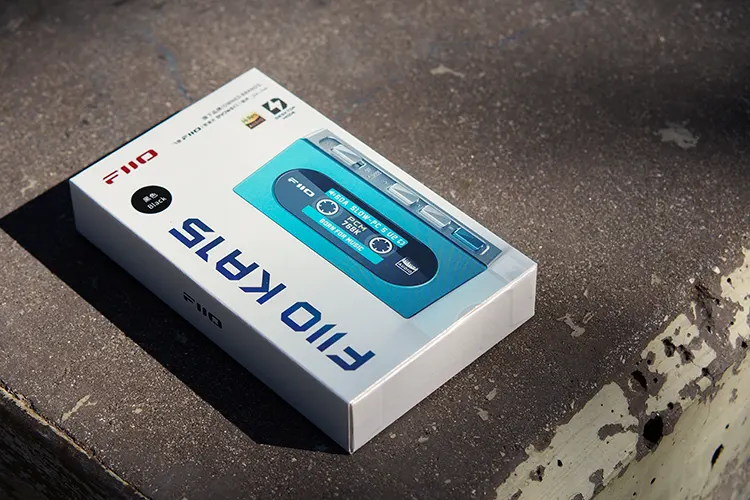Synergy
The KA15 synergizes well across a wide variety of sources and listening devices. The numerous EQ and filter options, power and output options, DAC styles, etc. allow users to fine-tune the listening experience and counter potential faults in their source and listening devices.
Efficiency
Even with extremely sensitive and picky earphones, like the Campfire Audio Andromeda 2020, through the single-ended 3.5mm output the KA15 has a low noise floor that provides a completely black background.
Between songs, with the volume low or off, there was nothing to be heard to interfere with the listening experience.
Shifting to the 4.4mm balanced out, a mild hiss was present through overly sensitive products, low enough to be completely inaudible once audio was playing, even during quiet moments.
With something with more average sensitivity and impedance ratings, like the FiiO FD3, noise was not an issue.
Power
Driving power is something the KA15 has in spades, providing up to 180mW via its single-ended output, and up to 560mW from the balanced out, with the desktop mode providing an extra boost if needed.
The way it outputs this power ensures hard-to-drive products can reach listening levels comfortably while providing a delicate enough output to ensure low listening levels are possible.
The Astrotec Phoenix, a hybrid with obscene requirements, is an IEM I often use to stress test DACs and Amps because most can’t push it adequately. Either the e-stats lack some drive and sound splashy and loose, or the dynamic loses depth and punch in the low end.
While the KA15’s single-ended output fails to meet the Phoenix’s demands and leaves the treble sounding loose and uninspired, even in desktop mode, swapping to the balanced out with desktop mode is enough to satisfy the Phoenix.
Most users should find the KA15 more than adequate for powering their gear, regardless of how demanding it is.
Pairings
Testing the KA15 across earphones with various signatures and specifications, it was most comfortable with products with average to more demanding specifications and a signature that wasn’t overly skewed in any one direction.
With more sensitive (aka. picky) earphones, the KA15 was subject to adding a bit of harshness and sharpness to the note presentation. There was a mild bump in texturing to go along with this, but the reduction in smoothness wasn’t to my taste.
With moderate to more demanding products, the KA15’s presentation was smooth and crisp through the entire frequency range.
I heard no loss of detail or distortion, even if running it at full volume on extremely demanding earphones/headphones and using the media source for volume control.
Select Comparisons
Earstudio HUD100
Technical
The KA15 provides PCM decoding up to 768kHz/32bit with DSD256 support. The HUD100 provides PCM decoding up to 384kHz/32bit with DSD128 support.
The KA15 utilizes dual Cirrus CS43198 DACS and dual SG Micro SGM8262 op-amps. The HUD100 uses a single Asahi Kasei AK4377 DAC.
The HUD100 uses an ARM Cortex processor and MEMS oscillator to utilize Radsone’s proprietary algorithm and minimize jitter.
Power outputs are measured differently on the two devices. On the KA15, the single-ended output is 180mW @ 32Ω, and through the balanced output, 560mW @ 32Ω.
The HUD100 outputs 1.29Vp from the standard output and 3.2Vp from the high-power output.
To compare output, I set my Huawei P40’s volume to 50% and the KA15’s onboard volume to 100% to mimic the HUD100 since it has no onboard volume control.
With these settings, the KA15 was notably louder from its single-ended output vs. the HUD100’s standard output. Using the KA15’s balanced output and the HUD100’s high-power output, their volume output was more comparable, though the KA15 was louder.
Design
Earsonics’ HUD100 is a wide, flat device, with a thickness that doesn’t exceed a 3.5mm port by more than a couple of millimeters. The KA15 is thicker and longer, but quite a bit thinner.
Both use aluminum for their shell which helps keep the weight down and durability up. The KA15 looks and feels more premium thanks to an anodized paint job and tempered glass covering a screen, all of which the HUD100 lacks.
They both use Type-C for USB interaction and feature 3.5mm single-ended outputs. For more power, the KA15 has a 4.4mm balanced output and a high-impedance desktop mode switch, while the HUD100 has another 3.5mm single-ended port, but with a higher output for more demanding gear.
The KA15 offers controls for volume and menu access/navigation, along with a toggle switch for the high-output desktop mode. The only physical control on the HUD100 is a switch on the rear used for firmware updates.
Performance
The HUD100 has been a go-to DAC for its analog sound and general competence with nearly everything I toss at it. The KA15 provides some overlap in terms of signature depending on the processing mode selected on the HUD100, but the experiences are different enough to warrant using both.
KA15 provides more upper treble shimmer than the HUD100 in either DCT or dynamic modes but offers a similar airiness and shimmer to the HUD100’s Bypass mode. Detail and clarity are similarly good, with the KA15’s note presentation being leaner and more defined.
The mids out of the HUD100 are thicker and warmer in the DCT mode, with similar weight and warmth to the KA15 in the Bypass and Dynamic modes. Clarity and texturing quality see minor improvements out of the KA15.
Timbre accuracy is strong from both, with neither shifting products to sound unnaturally bright, dark, bass, dry, etc. They both maintain a natural presentation.
KA15 provides more sub-bass rumble than the HUD100 when it is in either Bypass or DCT modes but slightly less when switching the HUD100 to its Dynamic mode where mid-bass punch is also more prominent on the HUD100.
Texturing and detail and again a hint better through the KA15, but the difference is minimal.
Staging is more open and deeper through the KA15 when the HUD100 is set to either DCT or Dynamic modes, while it opens to match the FiiO when adjusted to the Bypass mode.
Both DACs are equally impressive in maintaining imaging, layering, and instrument separation qualities across various products, with the KA15 seeing improvements with harder-to-drive and more demanding gear.
ddHiFi TC44C
Technical
The KA15 provides PCM decoding up to 768kHz/32bit with DSD256 support and the TC44C can decode up to PCM 384kHz/32bit with DSD 256 support.
The KA15 utilizes dual Cirrus CS43198 DACs and dual SG Micro SGM8262 op-amps. The TC44C uses dual Cirrus CS43131 DACs.
On the KA15, the single-ended output is 180mW @ 32Ω, and through the balanced output, 560mW @ 32Ω. I could only locate power specifications for the TC44C’s balanced output which is 120mW @ 32Ω.
To compare output, I set my Huawei P40’s volume to 50% and the KA15’s onboard volume to 100% to mimic the TC44C since it has no onboard volume control. With these settings, the KA15 was notably louder from single-ended and balanced output options.
Design
The TC44C is the smaller device overall. The KA15 is longer, wider, and slightly thinner.
Both have aluminum shells, though with very different designs. The TC44C has smooth, rounded sides with a gold-colored rear plate surrounding the Type-C port, a protrusion around the 3.5mm single-ended port with a slot for a wrist strap, and no physical controls.
The KA15 is a traditional rectangular prism with more defined, lightly rounded edges to keep it from feeling sharp. Physical controls for volume, menu navigation, and access to the desktop mode adorn one side, while the top contains a small glass-covered screen.
Both utilize Type-C USB ports for device connectivity. Both models offer 3.5mm single-ended and 4.4mm balanced output ports.
Performance
ddHiFi’s TC44C has been a go-to dongle of mine since it was released. It is powerful with a clean output and mostly neutral signature that leans warm but maintains the base qualities of the product in use.
The KA15 offers much the same experience but with improvements across the board. Starting with the upper ranges, the KA15 has a cleaner, tighter treble presentation.
This is most apparent with more demanding products, like the Astrotec Phoenix. Through the TCC44C the loose treble and metallic timbre I noted in my original review are present, but with the KA15 these qualities are absent.
The midrange presentation of the two is very similar with the moderate warmth of the signature thickening vocals. Through the KA15, there was a small bump to micro-detail and texture, with the same excellent timbre and tonality.
Bass is a strong point of both models, but again the KA15 provides moderate improvements. Texturing is more apparent, and I found the sub-bass to be more tactile and the mid-bass punch to be more impactful.
Staging is more even with neither model hindering the stock qualities of the earphones or headphones being paired. The KA15 slightly adds to the depth and layering qualities but the differences between it and the TC44C are hardly noticeable.
The KA15 is going to be replacing the TC44C in my lineup. It offers a similar auditory experience with minor improvements in most areas, along with a ton of extra features and a significant boost to the power output.
My Verdict
FiiO’s KA15 is a fantastic product that has replaced one of my go-to dongles for daily use.
It is a feature-packed device with tons of versatility allowing it to synergize exceptionally well with various listening devices and sources.
I also appreciate the outstanding build quality and unique visual flair afforded by the cassette-inspired graphics, which make it more interesting to use than your average dongle DAC.
My only complaint is the lack of a fourth control button that would allow you to reverse your way through the on-board menus.
It’s such a minor concern though since I didn’t find myself using the menus much beyond my initial testing, and it can easily be avoided entirely by using the FiiO Control app.
Beyond this, I have no complaints. The sound quality is great, the power output is more than enough for the vast majority of use cases, the specs are impressive, it’s versatile, looks good, and offers single-ended and balanced modes, with even more power available via the desktop mode.
Add to that a lower price than less feature-rich and less powerful models from the competition, and you’ve got yourself a winner. Good stuff FiiO!
FiiO KA15 Technical Specifications
- Decoding Support: up to PCM768kHz/32bit, DSD256
- Single-ended output power: L+R≥180mW+180mW (32Ω, THD+N<1%, USB IN)
- Balanced output power: L+R≥560mW+560mW (32Ω, THD+N<1%, USB IN)
- SNR: ≥123dB (32Ω, A-weighted)
- THD+N: <0.0004% (-4dB, 32Ω)
- Noise Floor: Single-ended – About 7uV@A-weighted; Balanced – About 3.2uV@A-weighted
- Dimension: 52x25x11mm
- Weight: 21g






